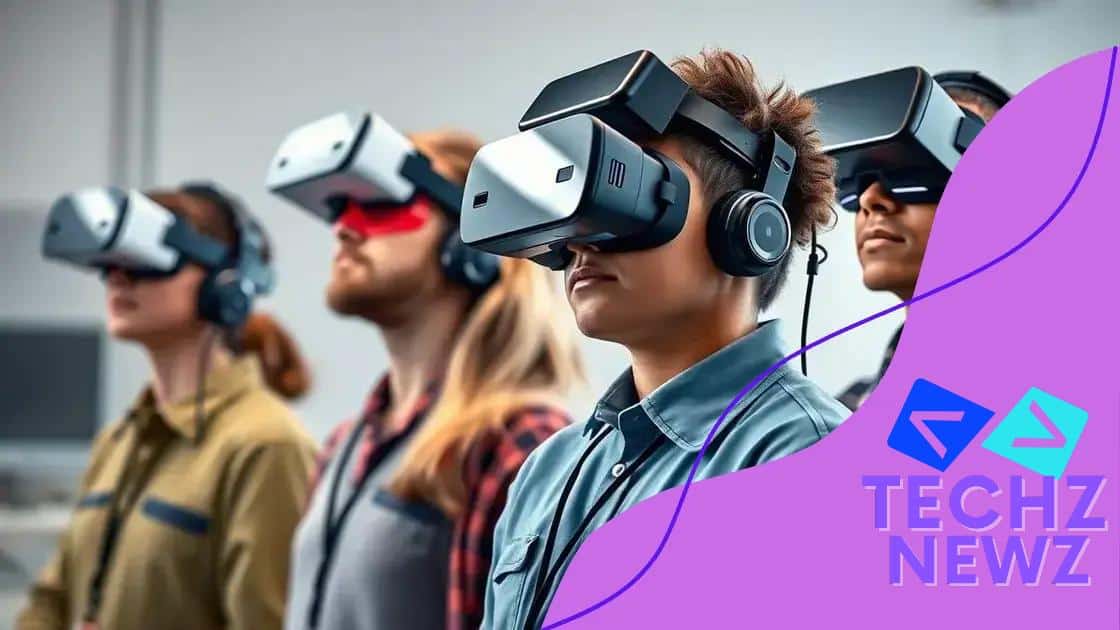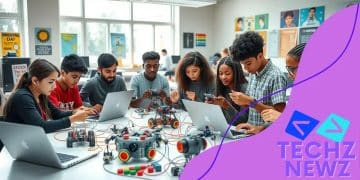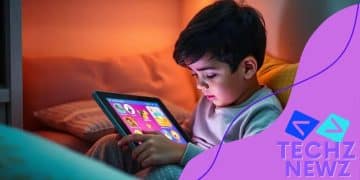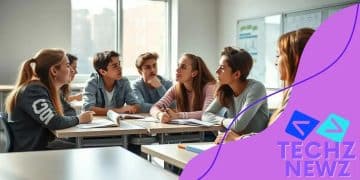Virtual reality for hands-on technical education: a game changer

Virtual reality for hands-on technical education enhances learning by providing immersive experiences that improve engagement, skill acquisition, and safety in practice scenarios while addressing challenges like cost and technical complexity.
Virtual reality for hands-on technical education is making waves in the learning landscape. Imagine stepping into a virtual world where you can practice skills without the risks associated with real-life scenarios. Intrigued? Let’s explore how this technology is shaping the future of education.
Introduction to virtual reality in education
Virtual reality is transforming how students learn, especially in technical fields. By immersing learners in realistic scenarios, they gain practical experience.
Understanding Virtual Reality
At its core, virtual reality (VR) creates simulated environments that feel real. This technology can replicate various settings, from factories to medical facilities, enabling students to practice skills safely.
Applications in Education
How is VR used in education? Here are some applications:
- Simulation training: Students can perform complex tasks in a risk-free space.
- Remote learning: It allows students in different locations to interact in the same virtual environment.
- Hands-on practice: Learners can try out skills without the need for physical tools.
This approach is especially valuable in fields like healthcare, engineering, and skilled trades, where hands-on experience is crucial.
As technology advances, more educational institutions are embracing virtual reality to enhance learning outcomes. Students are not just passive recipients of information; they are active participants in their education.
With VR, the learning experience becomes more engaging and effective. It can spark interest and motivation by offering students unique opportunities to explore and practice.
Benefits of VR in Learning
The benefits of using virtual reality in education are numerous. Here are some important advantages to consider:
- Enhances retention: Immersive learning improves memory and understanding.
- Encourages collaboration: Students can work together in shared virtual spaces.
- Reduces anxiety: Practicing in a safe environment helps students feel more confident.
As VR continues to grow in popularity, educators are excited about its potential. It not only makes learning fun but also prepares students better for real-world challenges by providing a practical, hands-on experience.
Benefits of virtual reality for hands-on skills
Virtual reality offers remarkable benefits for acquiring hands-on skills. Through immersive simulations, learners can practice and refine their abilities in a controlled environment.
Enhanced Engagement
One key benefit of VR is that it makes learning more engaging. Students become active participants in their education, which leads to higher motivation. Instead of passive listening, they can put their skills to the test in realistic scenarios.
Safe Learning Environment
In fields such as medicine and engineering, virtual reality provides a safe space for practice. Students can explore dangerous situations without real-world consequences. This helps reduce anxiety and builds confidence.
- Risk-free learning: Students can make mistakes and learn from them without risk.
- Immediate feedback: VR can offer instant feedback on performance, helping learners improve quickly.
- Repetition without cost: Practice can be repeated as often as needed without physical resources.
This approach helps solidify knowledge and develops muscle memory, which is crucial for technical skills. In addition, VR allows for a variety of scenarios that a traditional classroom cannot replicate.
Moreover, virtual reality training often leads to better retention of information. Students remember lessons longer when they actively engage with the material. They are more likely to recall their training when faced with real-world challenges.
Another important aspect is collaboration. Many VR platforms allow multiple users to interact with the same virtual environment. This fosters teamwork and communication skills, essential for success in the workplace.
Improved Accessibility
One of the most significant advantages of virtual reality is improved accessibility. Students from various backgrounds can access high-quality training regardless of location. This democratizes education and opens doors for everyone, including those who may not have access to traditional training resources.
As technology continues to evolve, the use of VR in hands-on skill training will only expand, offering even more opportunities for students to learn effectively and creatively.
Examples of VR applications in technical training

Virtual reality has many applications in technical training, providing immersive experiences that enhance learning. Let’s explore some notable examples of how this technology is being used.
Healthcare Training
In the medical field, VR is revolutionizing how students learn surgical procedures. Medical students can practice complex surgeries on virtual patients. This method allows them to build skills without risking real lives. Programs like Osso VR and Surgical Theater provide platforms for such training.
Automotive Repair
The automotive industry also benefits from virtual reality. Technicians can learn to diagnose and repair vehicles virtually. Programs allow them to explore engine components in detail and practice repairs using lifelike simulations. This enhances understanding and boosts confidence in their skills.
- Realistic scenarios: Trainees can experience real-life challenges in a safe space.
- Increased retention: Hands-on learning in VR helps reinforce knowledge.
- Accessibility: Students can learn at their own pace, anywhere.
These experiences are not only safer but more effective than traditional methods. VR makes it easier to grasp complex concepts through visualization and practice.
Construction and Engineering
In construction and engineering, students can use virtual reality to learn about building designs and safety protocols. They can walk through 3D models of buildings, identifying potential hazards. This sort of training helps prepare them for real-world environments where safety is crucial.
Furthermore, many companies use VR for training new employees. By familiarizing them with the job environment beforehand, they can better adapt and perform efficiently on the job. Companies see fewer accidents and improved job performance as a result.
Culinary Arts
Even in culinary arts, VR proves useful. Aspiring chefs can practice cooking techniques in a virtual kitchen. They can experiment with recipes and learn proper techniques without wasting ingredients. Programs also simulate food service scenarios, allowing students to enhance their customer service skills.
As more industries recognize the benefits of virtual reality, the range of applications continues to grow. This technology not only changes how skills are taught but also improves job readiness for students.
Challenges and limitations of VR in education
Virtual reality (VR) in education has numerous benefits, but it also faces significant challenges and limitations. It’s essential to understand these obstacles to make the most of this technology.
High Costs
One major challenge of implementing VR is the cost involved. Equipment such as headsets, software, and maintenance can be expensive. Many schools may struggle to secure funding for such technologies, making equitable access a challenge.
Technical Issues
Another limitation is the technical complexity of VR systems. Not every institution has the necessary technical support staff to maintain these systems effectively. Software updates, hardware malfunctions, and training staff can create additional burdens on schools.
- Learning curve: Teachers may need extra training to effectively integrate VR into their lessons.
- Compatibility issues: Not all VR software works seamlessly with existing hardware, leading to frustration.
- System failures: Technical glitches can disrupt learning experiences.
These issues can lead to negative experiences and decreased enthusiasm for VR education.
Health Concerns
There are also health concerns associated with VR usage. Prolonged use of VR headsets can lead to discomfort or motion sickness. Students may find it hard to concentrate if they experience nausea. This is particularly problematic in younger users, who may be more sensitive to the effects of VR.
Additionally, spending too much time in virtual environments can lead to a lack of social interaction in the real world. It’s essential to balance virtual learning with face-to-face interactions.
Content Limitations
Moreover, while many educational VR programs exist, content quality can vary significantly. Not all VR lessons align with educational standards, and some may lack depth. This inconsistency can hinder effective learning. As virtual reality is still a relatively new medium, content creators are still developing high-quality materials.
Finally, it’s vital to understand that VR will not replace traditional teaching methods. Instead, it should be seen as a complementary tool to enrich the learning experience. Schools and educators must navigate these challenges to maximize the potential benefits of VR in education.
Future trends in virtual reality for education
The future of virtual reality (VR) in education looks promising. As technology evolves, we can expect several trends that will shape how VR is used in classrooms.
Increased Accessibility
One significant trend is the increased accessibility of VR. As costs of VR technology decrease, more schools will adopt it. This means students worldwide will have better access to immersive experiences.
Enhanced Content Creation
Another trend is the growth in quality VR content. Developers are creating more educational simulations that are interactive and engaging. This content aligns with educational standards, providing teachers with effective teaching tools.
- Interactive simulations: VR will allow students to engage in hands-on learning.
- Culturally relevant materials: Content that reflects diverse perspectives will become more common.
- Real-world applications: Programs will focus on real-life skills and scenarios.
Such content can improve understanding and retention of material for students. By experiencing lessons in lifelike environments, they can grasp concepts more effectively.
Integration with Other Technologies
The integration of VR with other technologies is another exciting trend. For instance, combining VR with artificial intelligence can personalize learning experiences. AI can adapt lessons to each student’s pace and preferences, creating a tailored educational experience.
Furthermore, mixed reality might emerge, blending the physical and virtual worlds. This could lead to new ways for students to interact with information and their environment, enhancing their learning journey.
Focus on Social Interaction
As virtual reality develops, there will be an emphasis on social interaction in VR learning environments. Collaborative projects in VR can help students work together, regardless of physical location. This includes virtual classrooms where students can engage, discuss, and share ideas in real-time.
In the future, the role of teachers may evolve as well. Educators might become facilitators of learning experiences rather than traditional instructors. This shift can lead to more student-centered learning, where learners actively participate in their education.
As these trends emerge, the impact of virtual reality on education will be significant. The technology will not only enhance learning but also prepare students for a future where digital skills are essential.
FAQ – Frequently Asked Questions about Virtual Reality in Education
What are the main benefits of using VR in education?
VR enhances student engagement, provides hands-on experiences, and allows for safe practice in realistic scenarios.
What challenges do schools face when implementing VR?
Challenges include high costs, technical issues, and ensuring access to quality content.
How can VR improve skill acquisition for students?
By providing immersive and interactive simulations, VR helps students practice and retain skills better than traditional methods.
What future trends can we expect for VR in education?
We can expect increased accessibility, enhanced content quality, and greater integration with other technologies like AI.





